Maritime Transport: Impact of ASEAN and NAFTA Trade Blocs
VerifiedAdded on 2022/08/18
|10
|1581
|11
Report
AI Summary
This report examines the impact of trade blocs, specifically ASEAN and NAFTA, on maritime transport. It analyzes how these agreements influence shipping routes, container traffic, and overall economic growth within their respective regions. The report highlights the significant increase in maritime transport within the ASEAN region due to its geographical characteristics and established sea routes, contrasting this with the NAFTA region, where truck and rail transport dominate due to developed road infrastructure. The study utilizes statistical data and reports to illustrate trends in trade, GDP growth, and freight modes, offering a comparative analysis of the two trade blocs and their effects on the transport sector. It also includes a discussion of the factors contributing to the growth of maritime transport, such as free trade agreements, technological advancements, and increased global demand, while also providing an overview of the eight candidate trade routes within the ASEAN bloc. The report concludes by emphasizing the benefits of trade blocs for international trade and the differing impacts on maritime versus other transport modes in different regions.
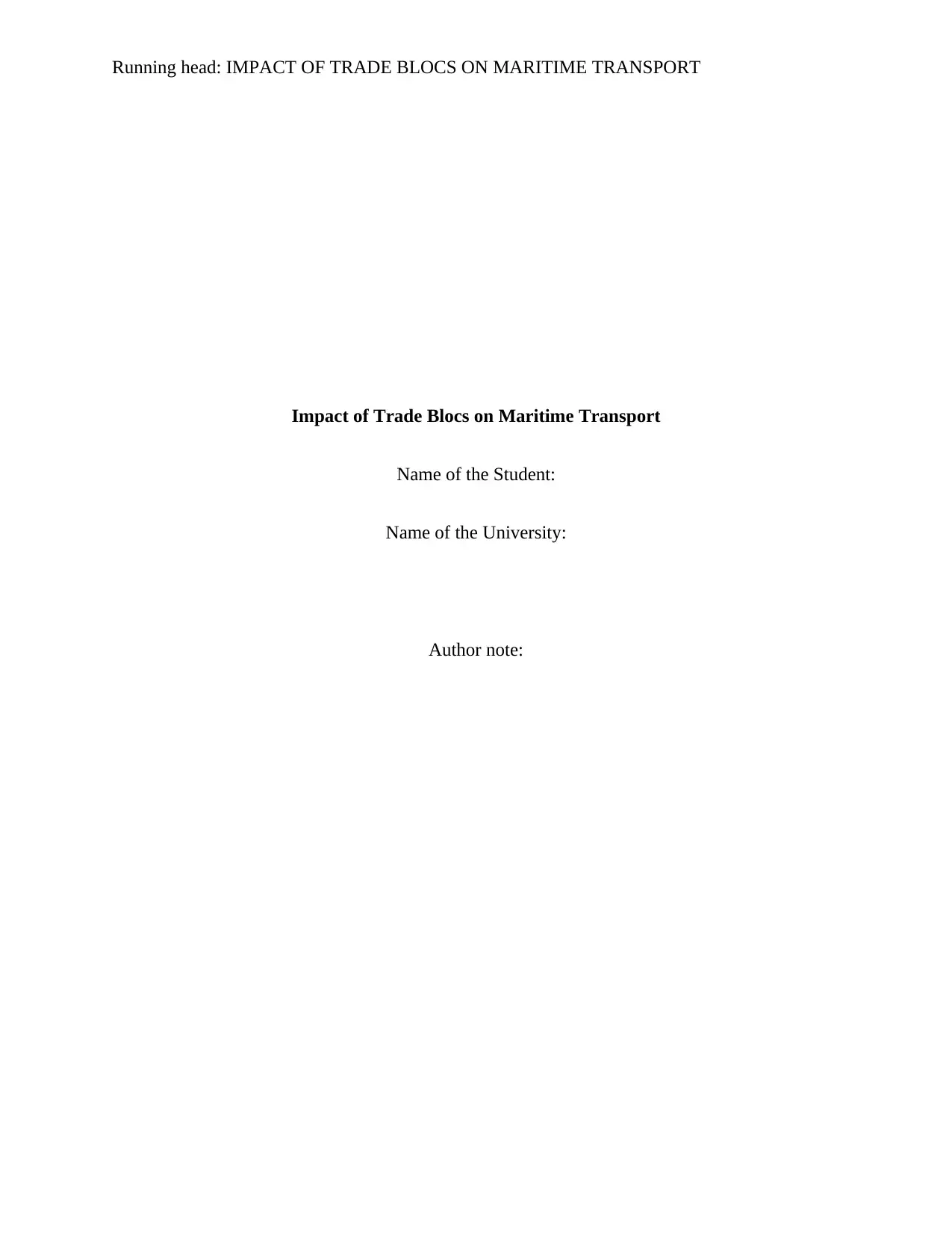
Running head: IMPACT OF TRADE BLOCS ON MARITIME TRANSPORT
Impact of Trade Blocs on Maritime Transport
Name of the Student:
Name of the University:
Author note:
Impact of Trade Blocs on Maritime Transport
Name of the Student:
Name of the University:
Author note:
Paraphrase This Document
Need a fresh take? Get an instant paraphrase of this document with our AI Paraphraser
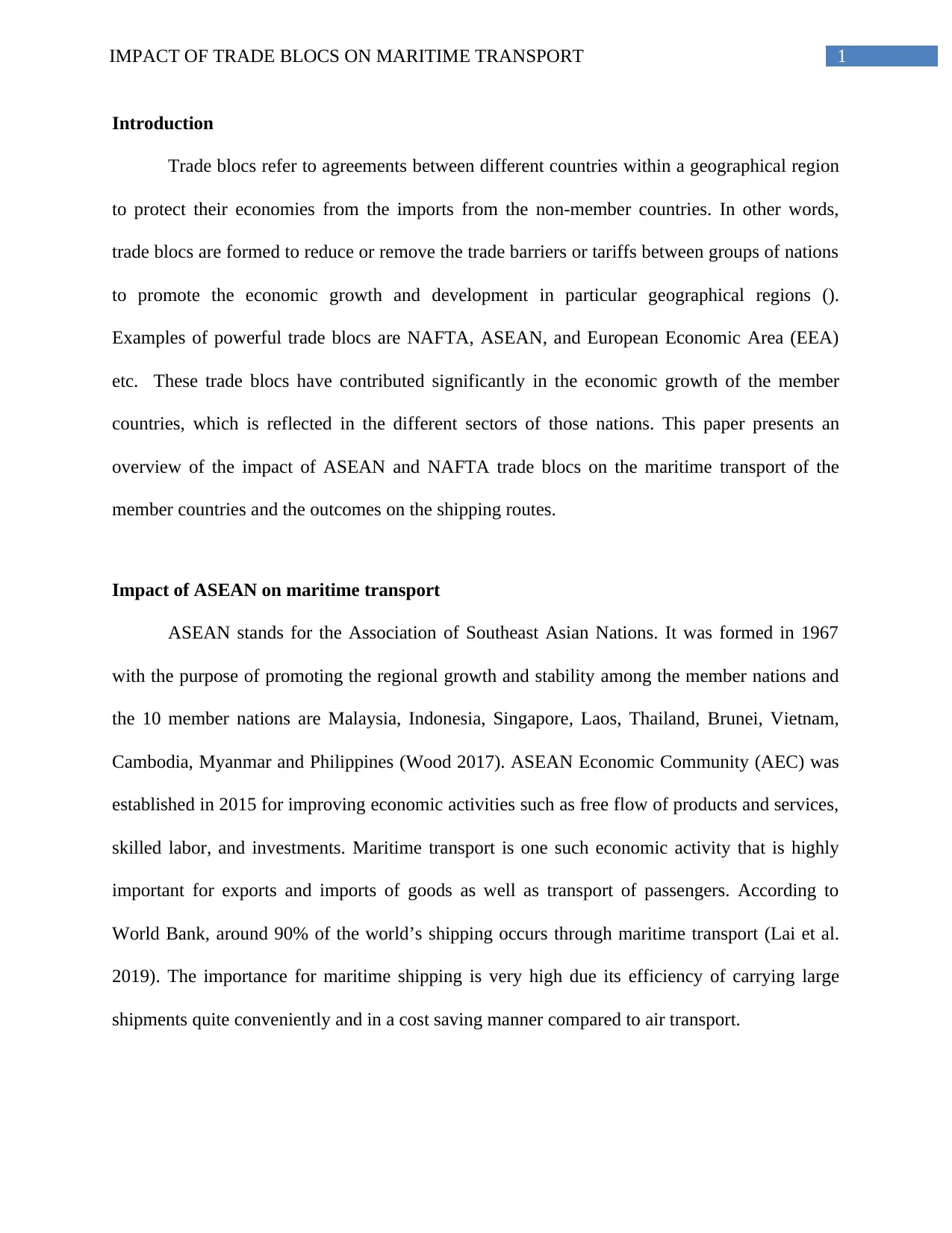
1IMPACT OF TRADE BLOCS ON MARITIME TRANSPORT
Introduction
Trade blocs refer to agreements between different countries within a geographical region
to protect their economies from the imports from the non-member countries. In other words,
trade blocs are formed to reduce or remove the trade barriers or tariffs between groups of nations
to promote the economic growth and development in particular geographical regions ().
Examples of powerful trade blocs are NAFTA, ASEAN, and European Economic Area (EEA)
etc. These trade blocs have contributed significantly in the economic growth of the member
countries, which is reflected in the different sectors of those nations. This paper presents an
overview of the impact of ASEAN and NAFTA trade blocs on the maritime transport of the
member countries and the outcomes on the shipping routes.
Impact of ASEAN on maritime transport
ASEAN stands for the Association of Southeast Asian Nations. It was formed in 1967
with the purpose of promoting the regional growth and stability among the member nations and
the 10 member nations are Malaysia, Indonesia, Singapore, Laos, Thailand, Brunei, Vietnam,
Cambodia, Myanmar and Philippines (Wood 2017). ASEAN Economic Community (AEC) was
established in 2015 for improving economic activities such as free flow of products and services,
skilled labor, and investments. Maritime transport is one such economic activity that is highly
important for exports and imports of goods as well as transport of passengers. According to
World Bank, around 90% of the world’s shipping occurs through maritime transport (Lai et al.
2019). The importance for maritime shipping is very high due its efficiency of carrying large
shipments quite conveniently and in a cost saving manner compared to air transport.
Introduction
Trade blocs refer to agreements between different countries within a geographical region
to protect their economies from the imports from the non-member countries. In other words,
trade blocs are formed to reduce or remove the trade barriers or tariffs between groups of nations
to promote the economic growth and development in particular geographical regions ().
Examples of powerful trade blocs are NAFTA, ASEAN, and European Economic Area (EEA)
etc. These trade blocs have contributed significantly in the economic growth of the member
countries, which is reflected in the different sectors of those nations. This paper presents an
overview of the impact of ASEAN and NAFTA trade blocs on the maritime transport of the
member countries and the outcomes on the shipping routes.
Impact of ASEAN on maritime transport
ASEAN stands for the Association of Southeast Asian Nations. It was formed in 1967
with the purpose of promoting the regional growth and stability among the member nations and
the 10 member nations are Malaysia, Indonesia, Singapore, Laos, Thailand, Brunei, Vietnam,
Cambodia, Myanmar and Philippines (Wood 2017). ASEAN Economic Community (AEC) was
established in 2015 for improving economic activities such as free flow of products and services,
skilled labor, and investments. Maritime transport is one such economic activity that is highly
important for exports and imports of goods as well as transport of passengers. According to
World Bank, around 90% of the world’s shipping occurs through maritime transport (Lai et al.
2019). The importance for maritime shipping is very high due its efficiency of carrying large
shipments quite conveniently and in a cost saving manner compared to air transport.
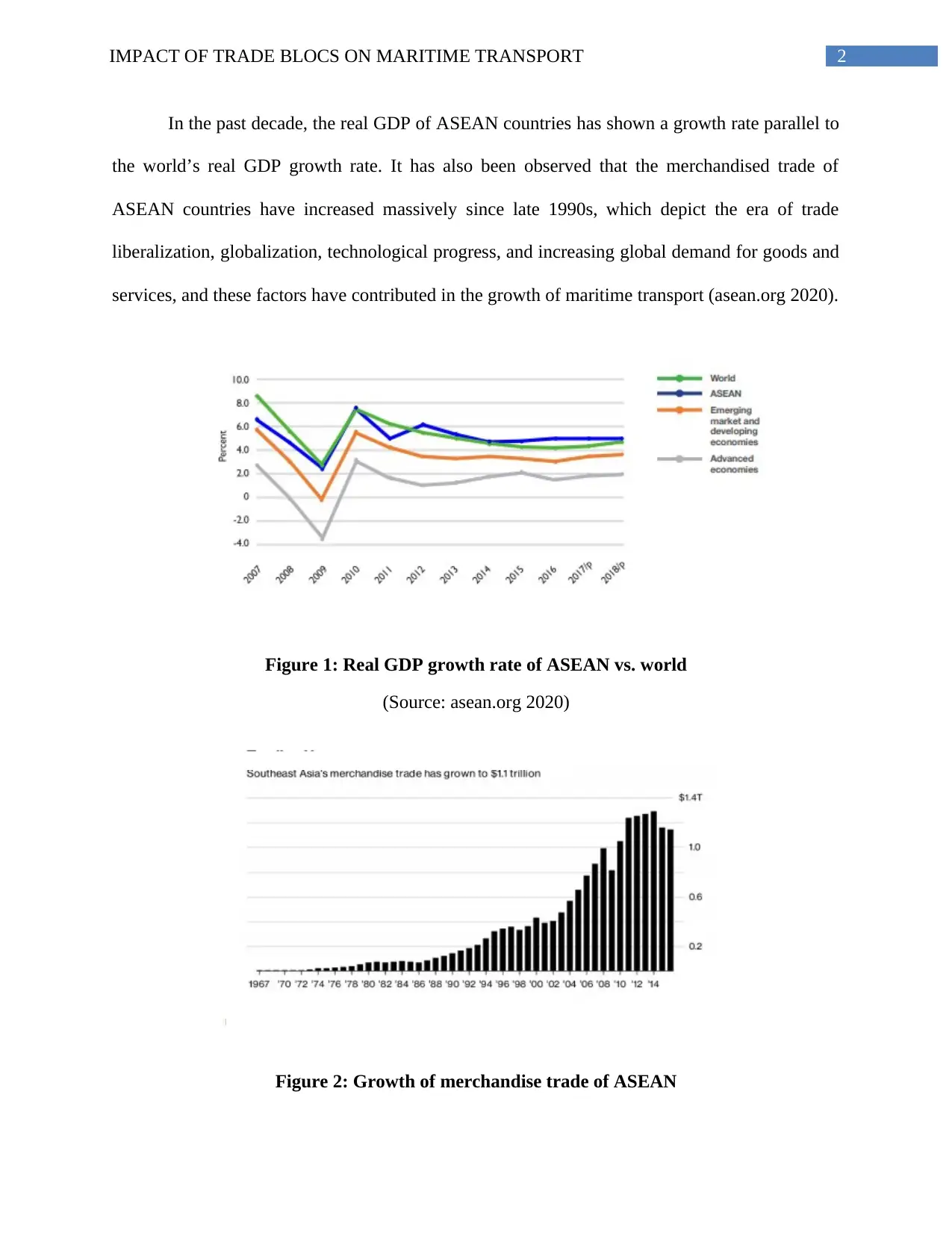
2IMPACT OF TRADE BLOCS ON MARITIME TRANSPORT
In the past decade, the real GDP of ASEAN countries has shown a growth rate parallel to
the world’s real GDP growth rate. It has also been observed that the merchandised trade of
ASEAN countries have increased massively since late 1990s, which depict the era of trade
liberalization, globalization, technological progress, and increasing global demand for goods and
services, and these factors have contributed in the growth of maritime transport (asean.org 2020).
Figure 1: Real GDP growth rate of ASEAN vs. world
(Source: asean.org 2020)
Figure 2: Growth of merchandise trade of ASEAN
In the past decade, the real GDP of ASEAN countries has shown a growth rate parallel to
the world’s real GDP growth rate. It has also been observed that the merchandised trade of
ASEAN countries have increased massively since late 1990s, which depict the era of trade
liberalization, globalization, technological progress, and increasing global demand for goods and
services, and these factors have contributed in the growth of maritime transport (asean.org 2020).
Figure 1: Real GDP growth rate of ASEAN vs. world
(Source: asean.org 2020)
Figure 2: Growth of merchandise trade of ASEAN
⊘ This is a preview!⊘
Do you want full access?
Subscribe today to unlock all pages.

Trusted by 1+ million students worldwide
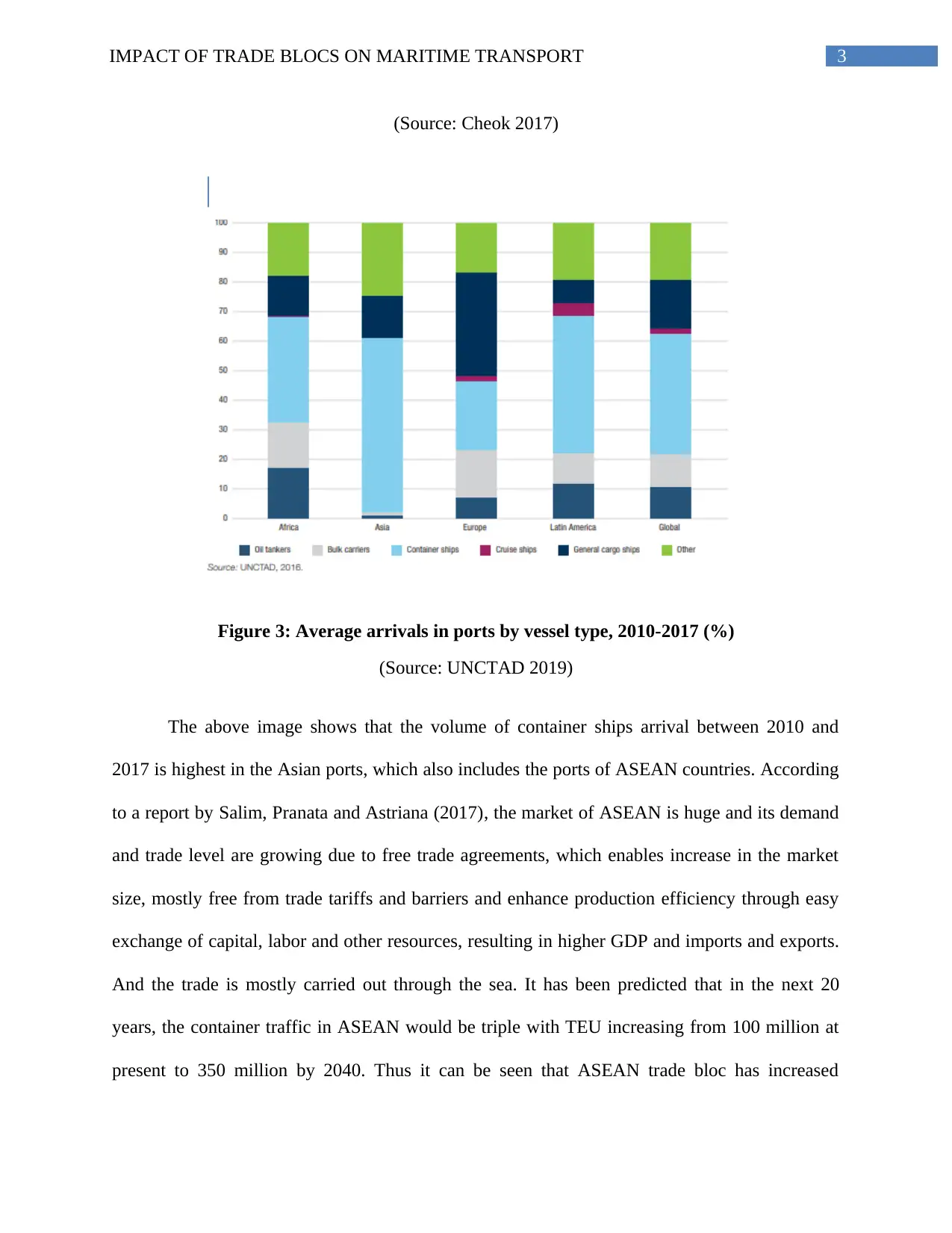
3IMPACT OF TRADE BLOCS ON MARITIME TRANSPORT
(Source: Cheok 2017)
Figure 3: Average arrivals in ports by vessel type, 2010-2017 (%)
(Source: UNCTAD 2019)
The above image shows that the volume of container ships arrival between 2010 and
2017 is highest in the Asian ports, which also includes the ports of ASEAN countries. According
to a report by Salim, Pranata and Astriana (2017), the market of ASEAN is huge and its demand
and trade level are growing due to free trade agreements, which enables increase in the market
size, mostly free from trade tariffs and barriers and enhance production efficiency through easy
exchange of capital, labor and other resources, resulting in higher GDP and imports and exports.
And the trade is mostly carried out through the sea. It has been predicted that in the next 20
years, the container traffic in ASEAN would be triple with TEU increasing from 100 million at
present to 350 million by 2040. Thus it can be seen that ASEAN trade bloc has increased
(Source: Cheok 2017)
Figure 3: Average arrivals in ports by vessel type, 2010-2017 (%)
(Source: UNCTAD 2019)
The above image shows that the volume of container ships arrival between 2010 and
2017 is highest in the Asian ports, which also includes the ports of ASEAN countries. According
to a report by Salim, Pranata and Astriana (2017), the market of ASEAN is huge and its demand
and trade level are growing due to free trade agreements, which enables increase in the market
size, mostly free from trade tariffs and barriers and enhance production efficiency through easy
exchange of capital, labor and other resources, resulting in higher GDP and imports and exports.
And the trade is mostly carried out through the sea. It has been predicted that in the next 20
years, the container traffic in ASEAN would be triple with TEU increasing from 100 million at
present to 350 million by 2040. Thus it can be seen that ASEAN trade bloc has increased
Paraphrase This Document
Need a fresh take? Get an instant paraphrase of this document with our AI Paraphraser
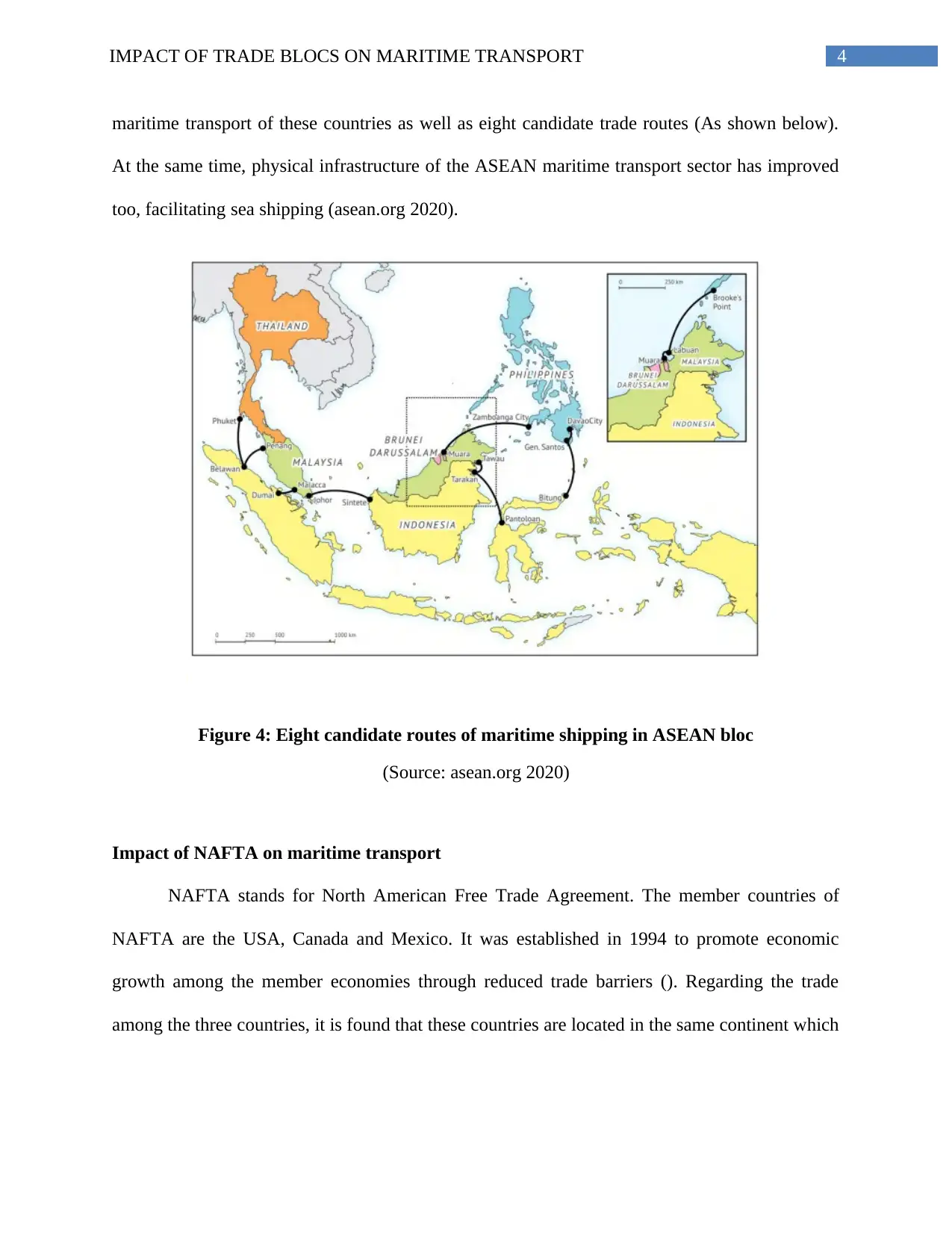
4IMPACT OF TRADE BLOCS ON MARITIME TRANSPORT
maritime transport of these countries as well as eight candidate trade routes (As shown below).
At the same time, physical infrastructure of the ASEAN maritime transport sector has improved
too, facilitating sea shipping (asean.org 2020).
Figure 4: Eight candidate routes of maritime shipping in ASEAN bloc
(Source: asean.org 2020)
Impact of NAFTA on maritime transport
NAFTA stands for North American Free Trade Agreement. The member countries of
NAFTA are the USA, Canada and Mexico. It was established in 1994 to promote economic
growth among the member economies through reduced trade barriers (). Regarding the trade
among the three countries, it is found that these countries are located in the same continent which
maritime transport of these countries as well as eight candidate trade routes (As shown below).
At the same time, physical infrastructure of the ASEAN maritime transport sector has improved
too, facilitating sea shipping (asean.org 2020).
Figure 4: Eight candidate routes of maritime shipping in ASEAN bloc
(Source: asean.org 2020)
Impact of NAFTA on maritime transport
NAFTA stands for North American Free Trade Agreement. The member countries of
NAFTA are the USA, Canada and Mexico. It was established in 1994 to promote economic
growth among the member economies through reduced trade barriers (). Regarding the trade
among the three countries, it is found that these countries are located in the same continent which
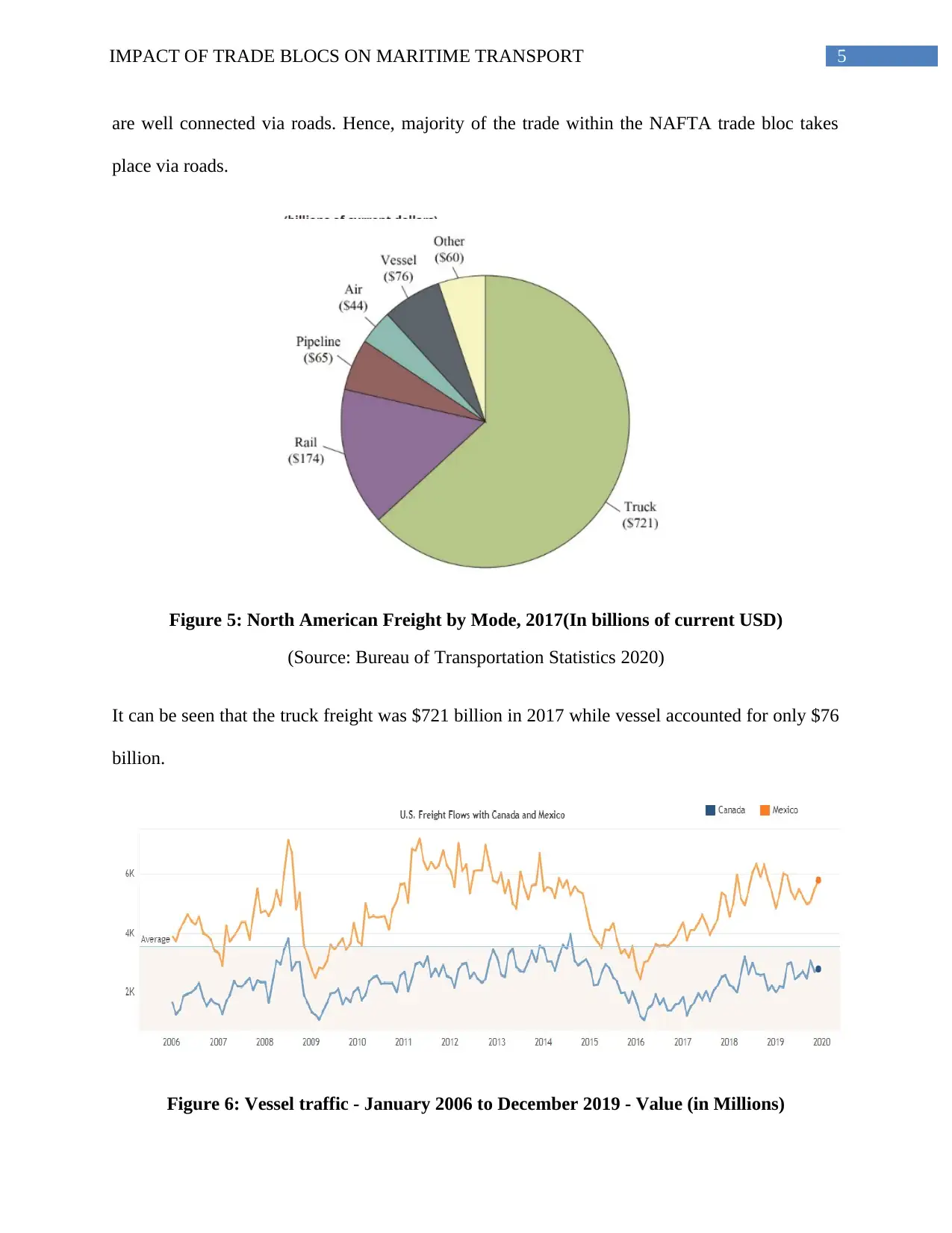
5IMPACT OF TRADE BLOCS ON MARITIME TRANSPORT
are well connected via roads. Hence, majority of the trade within the NAFTA trade bloc takes
place via roads.
Figure 5: North American Freight by Mode, 2017(In billions of current USD)
(Source: Bureau of Transportation Statistics 2020)
It can be seen that the truck freight was $721 billion in 2017 while vessel accounted for only $76
billion.
Figure 6: Vessel traffic - January 2006 to December 2019 - Value (in Millions)
are well connected via roads. Hence, majority of the trade within the NAFTA trade bloc takes
place via roads.
Figure 5: North American Freight by Mode, 2017(In billions of current USD)
(Source: Bureau of Transportation Statistics 2020)
It can be seen that the truck freight was $721 billion in 2017 while vessel accounted for only $76
billion.
Figure 6: Vessel traffic - January 2006 to December 2019 - Value (in Millions)
⊘ This is a preview!⊘
Do you want full access?
Subscribe today to unlock all pages.

Trusted by 1+ million students worldwide
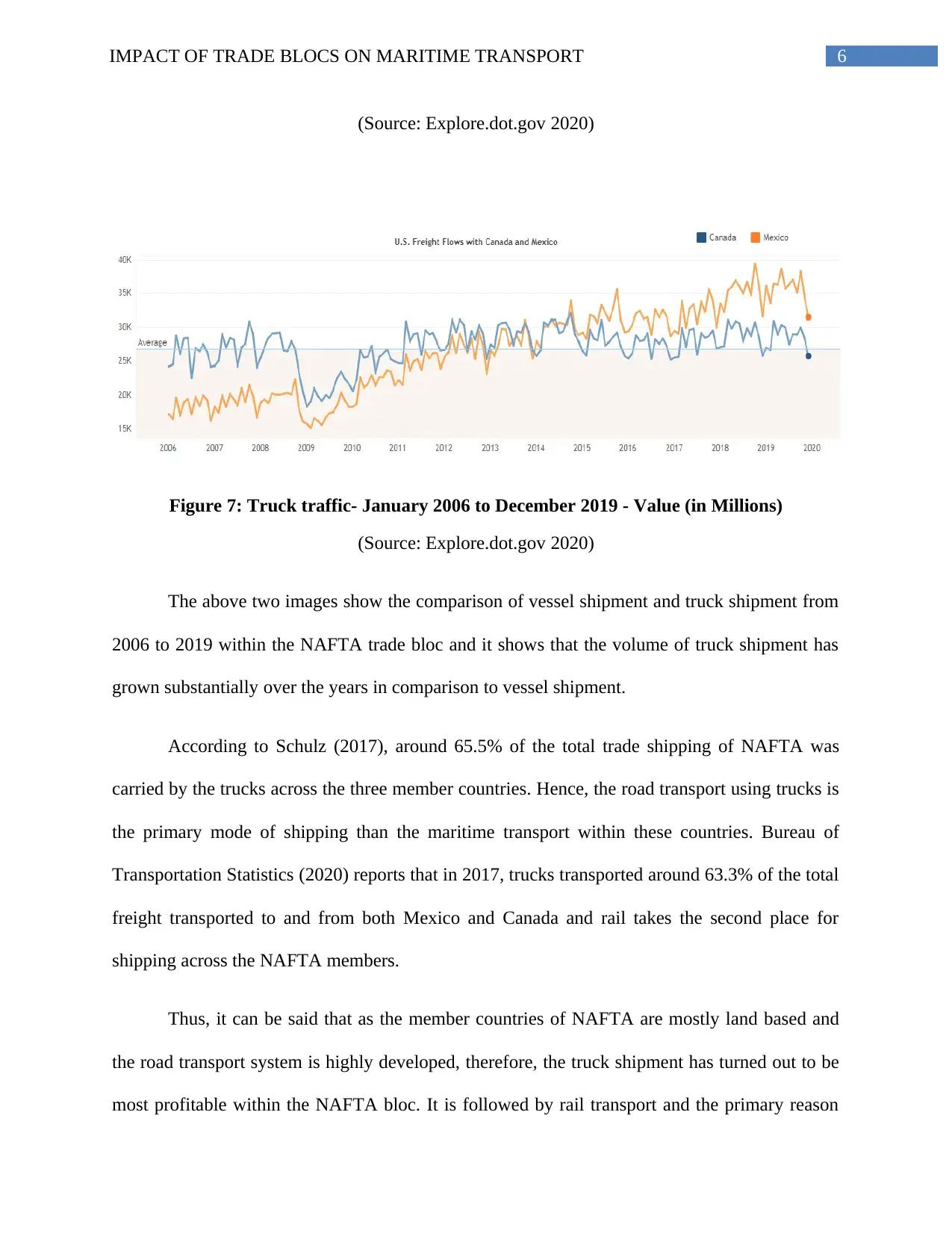
6IMPACT OF TRADE BLOCS ON MARITIME TRANSPORT
(Source: Explore.dot.gov 2020)
Figure 7: Truck traffic- January 2006 to December 2019 - Value (in Millions)
(Source: Explore.dot.gov 2020)
The above two images show the comparison of vessel shipment and truck shipment from
2006 to 2019 within the NAFTA trade bloc and it shows that the volume of truck shipment has
grown substantially over the years in comparison to vessel shipment.
According to Schulz (2017), around 65.5% of the total trade shipping of NAFTA was
carried by the trucks across the three member countries. Hence, the road transport using trucks is
the primary mode of shipping than the maritime transport within these countries. Bureau of
Transportation Statistics (2020) reports that in 2017, trucks transported around 63.3% of the total
freight transported to and from both Mexico and Canada and rail takes the second place for
shipping across the NAFTA members.
Thus, it can be said that as the member countries of NAFTA are mostly land based and
the road transport system is highly developed, therefore, the truck shipment has turned out to be
most profitable within the NAFTA bloc. It is followed by rail transport and the primary reason
(Source: Explore.dot.gov 2020)
Figure 7: Truck traffic- January 2006 to December 2019 - Value (in Millions)
(Source: Explore.dot.gov 2020)
The above two images show the comparison of vessel shipment and truck shipment from
2006 to 2019 within the NAFTA trade bloc and it shows that the volume of truck shipment has
grown substantially over the years in comparison to vessel shipment.
According to Schulz (2017), around 65.5% of the total trade shipping of NAFTA was
carried by the trucks across the three member countries. Hence, the road transport using trucks is
the primary mode of shipping than the maritime transport within these countries. Bureau of
Transportation Statistics (2020) reports that in 2017, trucks transported around 63.3% of the total
freight transported to and from both Mexico and Canada and rail takes the second place for
shipping across the NAFTA members.
Thus, it can be said that as the member countries of NAFTA are mostly land based and
the road transport system is highly developed, therefore, the truck shipment has turned out to be
most profitable within the NAFTA bloc. It is followed by rail transport and the primary reason
Paraphrase This Document
Need a fresh take? Get an instant paraphrase of this document with our AI Paraphraser
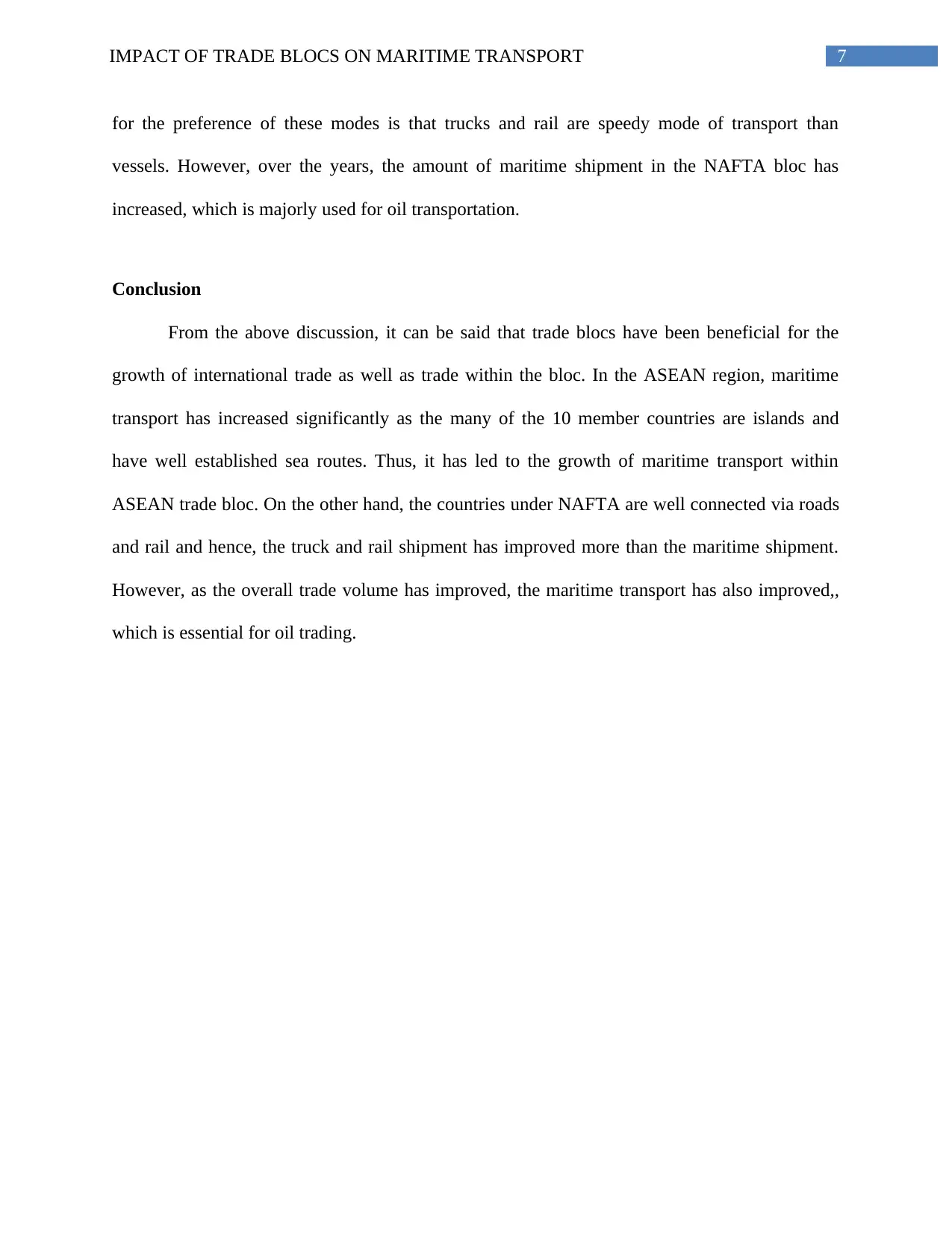
7IMPACT OF TRADE BLOCS ON MARITIME TRANSPORT
for the preference of these modes is that trucks and rail are speedy mode of transport than
vessels. However, over the years, the amount of maritime shipment in the NAFTA bloc has
increased, which is majorly used for oil transportation.
Conclusion
From the above discussion, it can be said that trade blocs have been beneficial for the
growth of international trade as well as trade within the bloc. In the ASEAN region, maritime
transport has increased significantly as the many of the 10 member countries are islands and
have well established sea routes. Thus, it has led to the growth of maritime transport within
ASEAN trade bloc. On the other hand, the countries under NAFTA are well connected via roads
and rail and hence, the truck and rail shipment has improved more than the maritime shipment.
However, as the overall trade volume has improved, the maritime transport has also improved,,
which is essential for oil trading.
for the preference of these modes is that trucks and rail are speedy mode of transport than
vessels. However, over the years, the amount of maritime shipment in the NAFTA bloc has
increased, which is majorly used for oil transportation.
Conclusion
From the above discussion, it can be said that trade blocs have been beneficial for the
growth of international trade as well as trade within the bloc. In the ASEAN region, maritime
transport has increased significantly as the many of the 10 member countries are islands and
have well established sea routes. Thus, it has led to the growth of maritime transport within
ASEAN trade bloc. On the other hand, the countries under NAFTA are well connected via roads
and rail and hence, the truck and rail shipment has improved more than the maritime shipment.
However, as the overall trade volume has improved, the maritime transport has also improved,,
which is essential for oil trading.
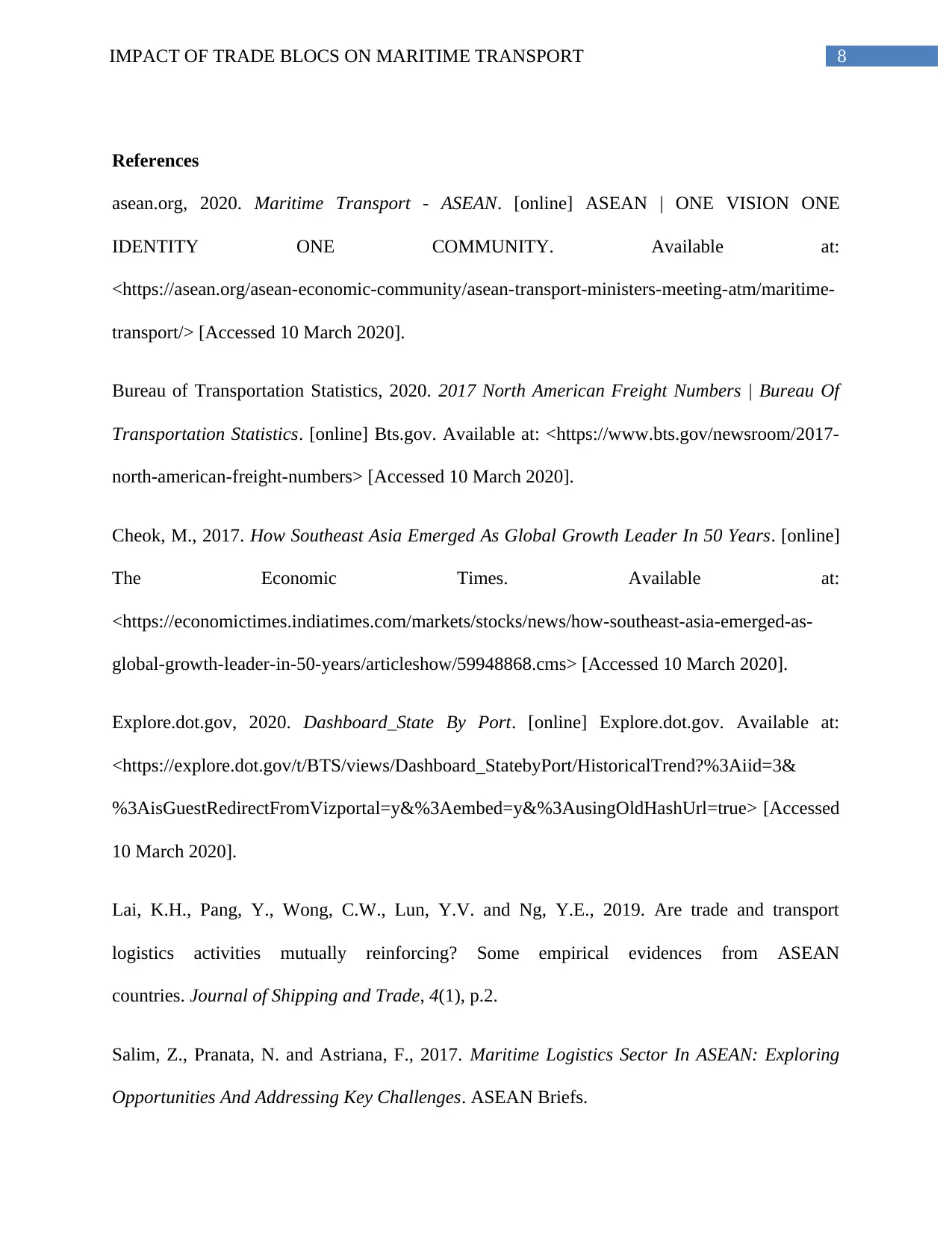
8IMPACT OF TRADE BLOCS ON MARITIME TRANSPORT
References
asean.org, 2020. Maritime Transport - ASEAN. [online] ASEAN | ONE VISION ONE
IDENTITY ONE COMMUNITY. Available at:
<https://asean.org/asean-economic-community/asean-transport-ministers-meeting-atm/maritime-
transport/> [Accessed 10 March 2020].
Bureau of Transportation Statistics, 2020. 2017 North American Freight Numbers | Bureau Of
Transportation Statistics. [online] Bts.gov. Available at: <https://www.bts.gov/newsroom/2017-
north-american-freight-numbers> [Accessed 10 March 2020].
Cheok, M., 2017. How Southeast Asia Emerged As Global Growth Leader In 50 Years. [online]
The Economic Times. Available at:
<https://economictimes.indiatimes.com/markets/stocks/news/how-southeast-asia-emerged-as-
global-growth-leader-in-50-years/articleshow/59948868.cms> [Accessed 10 March 2020].
Explore.dot.gov, 2020. Dashboard_State By Port. [online] Explore.dot.gov. Available at:
<https://explore.dot.gov/t/BTS/views/Dashboard_StatebyPort/HistoricalTrend?%3Aiid=3&
%3AisGuestRedirectFromVizportal=y&%3Aembed=y&%3AusingOldHashUrl=true> [Accessed
10 March 2020].
Lai, K.H., Pang, Y., Wong, C.W., Lun, Y.V. and Ng, Y.E., 2019. Are trade and transport
logistics activities mutually reinforcing? Some empirical evidences from ASEAN
countries. Journal of Shipping and Trade, 4(1), p.2.
Salim, Z., Pranata, N. and Astriana, F., 2017. Maritime Logistics Sector In ASEAN: Exploring
Opportunities And Addressing Key Challenges. ASEAN Briefs.
References
asean.org, 2020. Maritime Transport - ASEAN. [online] ASEAN | ONE VISION ONE
IDENTITY ONE COMMUNITY. Available at:
<https://asean.org/asean-economic-community/asean-transport-ministers-meeting-atm/maritime-
transport/> [Accessed 10 March 2020].
Bureau of Transportation Statistics, 2020. 2017 North American Freight Numbers | Bureau Of
Transportation Statistics. [online] Bts.gov. Available at: <https://www.bts.gov/newsroom/2017-
north-american-freight-numbers> [Accessed 10 March 2020].
Cheok, M., 2017. How Southeast Asia Emerged As Global Growth Leader In 50 Years. [online]
The Economic Times. Available at:
<https://economictimes.indiatimes.com/markets/stocks/news/how-southeast-asia-emerged-as-
global-growth-leader-in-50-years/articleshow/59948868.cms> [Accessed 10 March 2020].
Explore.dot.gov, 2020. Dashboard_State By Port. [online] Explore.dot.gov. Available at:
<https://explore.dot.gov/t/BTS/views/Dashboard_StatebyPort/HistoricalTrend?%3Aiid=3&
%3AisGuestRedirectFromVizportal=y&%3Aembed=y&%3AusingOldHashUrl=true> [Accessed
10 March 2020].
Lai, K.H., Pang, Y., Wong, C.W., Lun, Y.V. and Ng, Y.E., 2019. Are trade and transport
logistics activities mutually reinforcing? Some empirical evidences from ASEAN
countries. Journal of Shipping and Trade, 4(1), p.2.
Salim, Z., Pranata, N. and Astriana, F., 2017. Maritime Logistics Sector In ASEAN: Exploring
Opportunities And Addressing Key Challenges. ASEAN Briefs.
⊘ This is a preview!⊘
Do you want full access?
Subscribe today to unlock all pages.

Trusted by 1+ million students worldwide
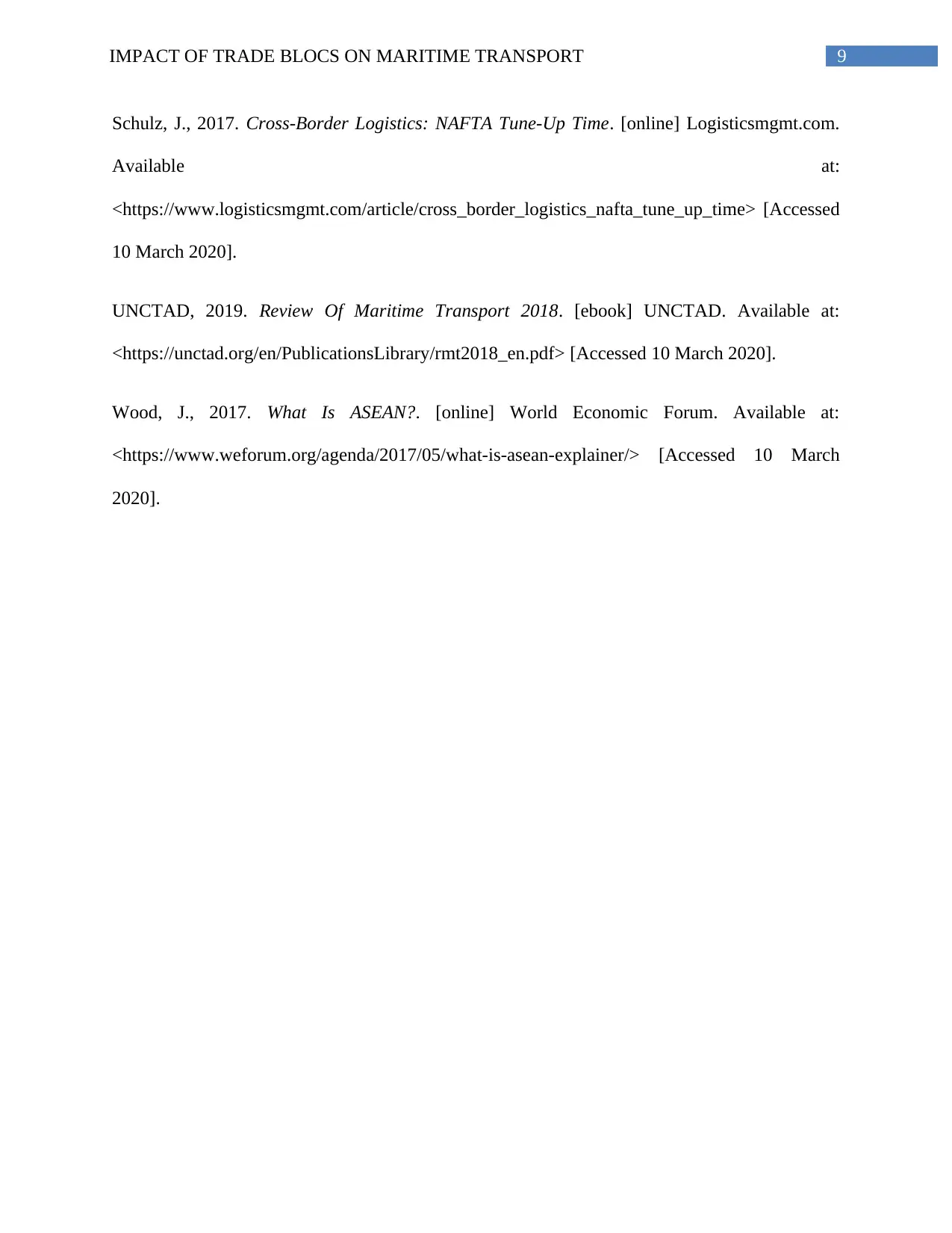
9IMPACT OF TRADE BLOCS ON MARITIME TRANSPORT
Schulz, J., 2017. Cross-Border Logistics: NAFTA Tune-Up Time. [online] Logisticsmgmt.com.
Available at:
<https://www.logisticsmgmt.com/article/cross_border_logistics_nafta_tune_up_time> [Accessed
10 March 2020].
UNCTAD, 2019. Review Of Maritime Transport 2018. [ebook] UNCTAD. Available at:
<https://unctad.org/en/PublicationsLibrary/rmt2018_en.pdf> [Accessed 10 March 2020].
Wood, J., 2017. What Is ASEAN?. [online] World Economic Forum. Available at:
<https://www.weforum.org/agenda/2017/05/what-is-asean-explainer/> [Accessed 10 March
2020].
Schulz, J., 2017. Cross-Border Logistics: NAFTA Tune-Up Time. [online] Logisticsmgmt.com.
Available at:
<https://www.logisticsmgmt.com/article/cross_border_logistics_nafta_tune_up_time> [Accessed
10 March 2020].
UNCTAD, 2019. Review Of Maritime Transport 2018. [ebook] UNCTAD. Available at:
<https://unctad.org/en/PublicationsLibrary/rmt2018_en.pdf> [Accessed 10 March 2020].
Wood, J., 2017. What Is ASEAN?. [online] World Economic Forum. Available at:
<https://www.weforum.org/agenda/2017/05/what-is-asean-explainer/> [Accessed 10 March
2020].
1 out of 10
Related Documents
Your All-in-One AI-Powered Toolkit for Academic Success.
+13062052269
info@desklib.com
Available 24*7 on WhatsApp / Email
![[object Object]](/_next/static/media/star-bottom.7253800d.svg)
Unlock your academic potential
Copyright © 2020–2025 A2Z Services. All Rights Reserved. Developed and managed by ZUCOL.





